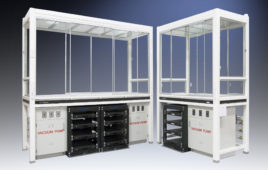Most of my industrial career with a large chemical company was spent doing development work. One lesson I learned only late, and with difficulty, was the importance of patience in the development of technology. This column uses three stories to explore different aspects and emphasize the importance of patience.
WHAT’S SO URGENT ABOUT PATIENCE?
We have all worked with or for people for whom patience was not a priority. In fact, I have been, and maybe still am, one of those. But I learned much of what little I know about the use of patience from the most successful college basketball coach, John R. Wooden.
 One of Wooden’s teachings was “Be quick, but don’t hurry!” Coach Wooden meant that basketball, like life, must be played fast but never out of control, and always in balance. “If you hurry,” he explained, “you are more likely to make mistakes, but if you’re not quick you won’t get things done. It’s like a surgeon who comes upon things unexpected. If he isn’t capable of responding quickly, he may lose the life of a patient. If an attorney isn’t a quick thinker, he could lose his case.” To be in balance, one must have patience.
One of Wooden’s teachings was “Be quick, but don’t hurry!” Coach Wooden meant that basketball, like life, must be played fast but never out of control, and always in balance. “If you hurry,” he explained, “you are more likely to make mistakes, but if you’re not quick you won’t get things done. It’s like a surgeon who comes upon things unexpected. If he isn’t capable of responding quickly, he may lose the life of a patient. If an attorney isn’t a quick thinker, he could lose his case.” To be in balance, one must have patience.
SOMETIMES YOU JUST HAVE TO WAIT
Back in the late 1920s, Professor Thomas Parnell, of the University of Queensland in Brisbane, Australia, wished to show his students that pitch (tar or paving asphalt) was a fluid not only on very hot days or just after being poured, but all the time. So he set up an apparatus to demonstrate this: the ultimate slow drip.
Parnell began his demonstration in 1927 by melting down some pitch, making sure it was evenly mixed, and then pouring it into a funnel. The funnel was sealed at the bottom, to prevent the pitch from flowing right through. It wasn’t until 1930 that the seal was removed. Parnell wanted to be sure that the pitch was completely cooled before the experiment could be started!
The tip of the funnel was opened and students waited for the first drip. They then graduated, and a new batch of students waited for the drip. They graduated, and the next batch of students saw the first drip of pitch, which came in 1938. The next one came in 1947, and the next in 1954. Drips came about once every decade, except the 1970s when two drops fell, one in 1970 and another in 1979. The nineties, on the other hand, were dropless. The next drip is expected sometime in 2012.1
Obvious in this story is the lesson that patience is not just a virtue, but a requirement in technical development.
But, one has to know by judgment just when patience should be replaced with action on another front.

A MODEL FOR CONSULTANTS (AND CLIENTS)
Charles Proteus Steinmetz has been unjustly forgotten. A German-born scientist who counted Einstein, Edison, and Tesla among his collaborators, he was a dwarf, suffering from an abnormal curvature of the upper spine. But his mind was among the best of his era, leading to major breakthrough developments in both direct and alternating current power generation. In one development, he helped Henry Ford’s engineers solve their problems with a generator in the River Rouge plant in Dearborn, Michigan. The story goes like this:
Steinmetz listened to the generator and scribbled computations on the notepad for two straight days and nights. On the second night, he asked for a ladder, climbed up the generator, and made a chalk mark on its side. Then he told Ford’s skeptical engineers to remove a plate at the mark and replace sixteen windings from the field coil. They did, and the generator performed to perfection.
Steinmetz then presented Ford with a bill for $10,000. Ford, in turn, asked for an itemized bill, balking a bit at the high price tag. Steinmetz obliged, itemizing $1 for making the chalk mark on the generator and $9,999 for “knowing where to make the mark.” Lacking the patience to wait for his own staff to make the generator work, Ford paid the bill. Having the patience to listen for two days, Steinmetz earned a plush fee.2
THE INVISIBLE VECTOR
Patience is an invisible vector. Its various directions and dimensions cannot be seen, but only experienced. Successful technology developers know how to be quick but not hurry; decide when to invest resources seemingly forever, as did Chester Carlson into that which became xerography; and like Steinmetz, take the time to learn to place the X at the exact spot where the treasure lay.
References
- See http://www.physics.uq.edu.au/physics_museum/pitchdrop.shtml.
- This story is taken from Scientific American Magazine’s blog by Jennifer Ouellette, August 19, 2011.
John Durkee is the author of the book Management of Industrial Cleaning Technology and Processes, published by Elsevier (ISBN 0- 0804-48887). He is the author of the forthcoming book Solvent Cleaning for the 21st Century, also to be published by Elsevier, and is an independent consultant specializing in critical cleaning. You can contact him at PO Box 847, Hunt, TX 78024 or 122 Ridge Road West, Hunt, TX 78024; 830-238-7610; Fax 612-677-3170; or [email protected].




